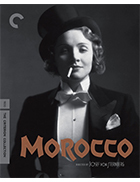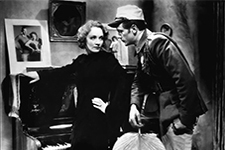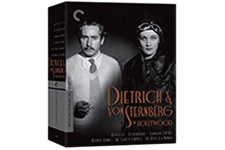| Director: Josef von Sternberg | | Screenplay: Jules Furthman (based on the book Amy Jolly by Benno Vigny) | | Stars: Gary Cooper (Légionnaire Tom Brown), Marlene Dietrich (Mademoiselle Amy Jolly), Adolphe Menjou (Monsieur La Bessiere), Ullrich Haupt (Adjutant Caesar), Eve Southern (Madame Caesar), Francis McDonald (Sergeant Tatoche), Paul Porcasi (Lo Tinto) | | MPAA Rating: NR | | Year of Release: 1930 | | Country: U.S. |  |
|  Josef von Sternberg’s Morocco is a good—not great—film, although it does have one undeniably great sequence. When the film is mentioned, the first thing people tend to think of is the infamous sequence in which Marlene Dietrich’s Amy Jolly, an extremely self-confident and highly sexualized cabaret singer, performs a French song while dressed in male drag—a white-tie tuxedo and top hat—and then stuns the patrons by slinking into the audience and kissing not a man, but another woman. As a Pre-Code film (meaning that it was released before the Hollywood studios started fully abiding by the moral strictures of their self-imposed Production Code), Morocco was notably daring, not only for that overt moment of teasing same-sex physicality, but in depicting Amy Jolly as a powerful woman with her own agenda, desires, and willingness to pursue them (she seems like a more cosmopolitan and less ribald version of the Mae West persona). Morocco, of course, is the film that made Marlene Dietrich a Hollywood star and international icon, and it was the first of six films she made with von Sternberg for Paramount between 1930 and 1935. They had already collaborated the year before on the German production The Blue Angel (Der blaue Engel, 1930), in which Dietrich also played a cabaret singer. The chemistry between director and star was so electric that Paramount paired them again and even delayed the U.S. release of the German film so that Morocco could serve as their introduction to American audiences. Von Sternberg, who was Austrian but had been born in Vienna and spent a great deal of his childhood in New York, has been directing films in the U.S. since the mid-1920s, including the highly influential gangster film Underworld (1927). But, it was Morocco that truly cemented his standing, partially because it demonstrated so powerfully his unique visual sensibility and willingness to defy narrative convention in pursuit of unforgettable imagery. And this is precisely why the film must be forgiven its relatively lackluster storyline, which concerns the impossible romance between Amy Jolly and Tom Brown (Gary Cooper), a handsome Légionnaire who catches her eye during her gender-bending cabaret routine. Amy is already in the sights of Monsieur La Bessiere (Adolphe Menjou), a wealthy older gentleman who pursues her as an object to be won, but she has little interest in him. Instead, she is drawn to Brown, an unconventional soldier of fortune who Cooper portrays with his unique aw-shucks sensibility that feels completely, even gloriously, out of place in the sands of north Africa. The narrative beats, mapped out by screenwriter Jules Furthman from the novel by Benno Vigny, are quite familiar, especially in the way Amy Jolly and Tom Brown feel forever destined to be apart even when we know they should be together. Cooper and Dietrich have a unique romantic chemistry, although it is memorable mainly for its oddness, rather than any heat it generates. Yet, Morocco maintains a constant interest if only because von Sternberg, working with pioneering veteran cinematographer Lee Garmes (Scarface, Shanghai Express), makes it so imminently watchable with his complex visuals. Being an early synchronized sound film, Morocco was hobbled to some extent by technical limitations (the camera is much more static that it is in von Sternberg’s visually dexterous silent films and in his later sound films), and at times you can feel him straining against the imposition, which makes it that much more fascinating, although not any more emotionally engaging. | Morocco Criterion Collection Blu-ray |  Morocco is available exclusively as part of the Criterion Collection’s “Dietrich & Von Sternberg in Hollywood” boxset, which also includes Dishonored (1931), Shanghai Express (1932), Blonde Venus (1932), The Scarlet Empress (1934), and The Devil Is a Woman (1935). Morocco is available exclusively as part of the Criterion Collection’s “Dietrich & Von Sternberg in Hollywood” boxset, which also includes Dishonored (1931), Shanghai Express (1932), Blonde Venus (1932), The Scarlet Empress (1934), and The Devil Is a Woman (1935). | | Aspect Ratio | 1.19:1 | | Audio | English Linear PCM 1.0 monaural | | Subtitles | English | | Supplements | New interviews with film scholars Janet Bergstrom and Homay King; director Josef von Sternberg’s son, Nicholas; Deutsche Kinemathek curator Silke Ronneburg; and costume designer and historian Deborah Nadoolman LandisNew documentary about actor Marlene Dietrich’s German origins, featuring film scholars Gerd Gemünden and Noah IsenbergNew documentary on Dietrich’s status as a feminist icon, featuring film scholars Mary Desjardins, Amy Lawrence, and Patricia WhiteThe Legionnaire and the Lady, a 1936 Lux Radio Theatre adaptation of Morocco, featuring Dietrich and actor Clark GableNew video essay by critics Cristina Álvarez López and Adrian MartinThe Fashion Side of Hollywood, a 1935 publicity short featuring Dietrich and costume designer Travis BantonTelevision interview with Dietrich from 1971Insert book featuring essays by critics Imogen Sara Smith, Gary Giddins, and Farran Smith Nehme | | Distributor | The Criterion Collection | | SRP | $124.95 | | Release Date | July 3, 2018 | | | COMMENTS | | Calling Criterion’s Dietrich & Von Sternberg in Hollywood a major release doesn’t quite do it justice, as the set pulls together six major films that represent the near entirety of one of the most important, fascinating, and influential director-actor collaborations in film history. Not only does the Criterion boxset include all six of the films Marlene Dietrich and Josef von Sternberg made together during their years working for Paramount (the only exclusion is 1930’s The Blue Angel, which was a German production distributed in the U.S. by Paramount), but there is a host of extras that contextualize the films historically and aesthetically and help us better appreciate the artistry of Dietrich and von Sternberg. In terms of sound and image, all six films are in the best condition they’ve ever been in on home video. Given that all of the films were made between 1930 and 1935, they certainly reflect the style and quality of filmstock, cameras, and sound recording technologies at that time, which is how it should be. Morocco and Dishonored, both of which were early synchronized sound films, are both presented in their proper 1.19:1 aspect ratio, which reflects the compromise made at the time to use the silent-era parameters of 35mm film stock and take away from of the image to make room for the optical soundtrack. The other four films are presented in their 1.33:1 or 1.37:1 Academy aspect ratio. Morocco was transferred in 2K from a 35mm safety fine-grain held by the UCLA Film & Television Archive; Dishonored, Blonde Venus, and The Scarlet Empress were all transferred in 4K from 35mm nitrate prints held by the UCLA Film & Television Archive; Shanghai Express was transferred in 4K from a 35mm duplicate negative and a composite fine-grain print by Universal Pictures; and The Devil Is a Woman was also transferred in 4K from a 35mm safety duplicate negative. Extensive digital restoration was performed on all six films, leaving them as clean and blemish-free as one could possibly expect. The image quality of the films gradually improves with each one, not necessarily because of the transfers, but because of the improvements in film stock and the slightly increased resolution of the later sound films. Morocco definitely looks the softest and the grainiest, while the later films have a much sharper appearance, with stronger contrast and finer detail, albeit with plenty of film grain still present. Criterion had previously released The Scarlet Empress on DVD, and the comparison between that transfer and the new one is substantial, with the new high-definition presentation bearing remarkably better depth and detail and with none of the visible wear and tear of the earlier transfer. Like the image quality, the sound quality of each film is very good, although representative of the technological limitations of the time. The monaural soundtrack for Morocco was mastered from a 35mm safety fine-grain; Dishonored, Blonde Venus, and The Scarlet Empress’s soundtracks were mastered from their respective 35mm nitrate prints, while The Devil Is a Woman track was mastered from a 35mm soundtrack positive. And, finally, Shanghai Express’s soundtrack was mastered and restored by Universal from a 35mm optical soundtrack negative. The supplements, which together comprise hours of material, are scattered across the six discs. The Morocco disc features “Weimar on the Pacific” (30 min.), a detailed featurette about Dietrich’s German origins that features interviews with film scholars Gerd Gemünden and Noah Isenberg; “Crazy Love,” a 31-minute interview with film scholar Janet Bergstrom about Morocco’s production and reception; “The Real Amy Jolly” (20 min.), an interview with Deutsche Kinemathek curator Silke Ronneburg (who shows up in another featurette on the Blonde Venus disc) about the real-life woman on whom the Dietrich character is based; and “The Legionnaire and the Lady,” a 60-minute Lux Radio Theatre adaptation of Morocco from 1936 that features Dietrich reprising her role and Clark Gable standing in for Gary Cooper. The Dishonored disc includes “Bodies and Spaces, Fabric and Light” (30 min.), an absolutely fascinating video essay by film scholars Cristina Alvarez Lopez and Adrian Martin about von Sternberg’s unique visual style; “Dietrich Icon” (20 min.), a featurette in which film scholars Mary Desjardine, Amy Lawrence, and Patricia White discuss how Dietrich became a complex and subversive Hollywood icon in her collaboration with von Sternberg; and a video interview with von Sternberg’s son, Nicholas, from 2014. The Shanghai Express disc includes only one supplement, but it is a great one: a 23-minute interview with film scholar Homay King, author of Lost in Translation: Orientalism, Cinema, and the Enigmatic Signifier, about the film’s complicated and, in some regards, regressive depiction of the “exotic” East. The Blonde Venus disc includes “The Fashion Side of Hollywood” (10 min.), a publicity short from 1935 that features Dietrich modeling clothes designed for her by costume designer Travis Banton, and “The Marlene Dietrich Collection” (15 min.), a 15-minute featurette about the immense collection of Dietrich memorabilia housed at the Deutsche Kinemathek in Berlin, featuring an interview with curator Silke Ronneburg. The Scarlet Empress and The Devil Is a Woman discs also have only one supplement each: On the former, we have “Marlene Dietrich in Denmark” (29 min.), a retrospective interview with Dietrich from 1971 that aired on Swedish television, while on the latter we have the audio from a 78 rpm promotional disc of the song “If It Isn’t Pain,” which had to be cut from the film due to restrictions by the Production Code Administration (PCA). Finally, the boxset is packaged with a thick insert book that features essays on each film by critics Imogen Sara Smith, Gary Giddins, and Farran Smith Nehme. |
Copyright © 2018 James Kendrick Thoughts? E-mail James Kendrick All images copyright © The Criterion Collection |



 (3)
(3)

 Morocco is available exclusively as part of the Criterion Collection’s “Dietrich & Von Sternberg in Hollywood” boxset, which also includes Dishonored (1931), Shanghai Express (1932), Blonde Venus (1932), The Scarlet Empress (1934), and The Devil Is a Woman (1935).
Morocco is available exclusively as part of the Criterion Collection’s “Dietrich & Von Sternberg in Hollywood” boxset, which also includes Dishonored (1931), Shanghai Express (1932), Blonde Venus (1932), The Scarlet Empress (1934), and The Devil Is a Woman (1935).